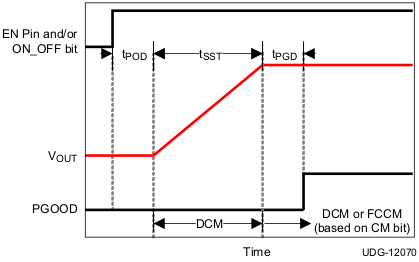JAJSH64B November 2012 – April 2019 TPS53819A
PRODUCTION DATA.
- 1 特長
- 2 アプリケーション
- 3 概要
- 4 改訂履歴
- 5 Pin Configuration and Functions
- 6 Specifications
-
7 Detailed Description
- 7.1 Overview
- 7.2 Functional Block Diagram
- 7.3
Feature Description
- 7.3.1 Enable and Soft-Start
- 7.3.2 Adaptive On-Time Control
- 7.3.3 Zero Crossing Detection
- 7.3.4 Output Discharge Control
- 7.3.5 Low-Side Driver
- 7.3.6 High-Side Driver
- 7.3.7 Power Good
- 7.3.8 Current Sense and Overcurrent Protection
- 7.3.9 Overvoltage and Undervoltage Protection
- 7.3.10 Out-of-Bound Protection
- 7.3.11 UVLO Protection
- 7.3.12 Thermal Shutdown
- 7.4 Device Functional Modes
- 7.5 Programming
- 7.6
Register Maps
- 7.6.1 OPERATION [01h] (R/W Byte)
- 7.6.2 ON_OFF_CONFIG [02h] (R/W Byte)
- 7.6.3 WRITE_PROTECT [10h] (R/W Byte)
- 7.6.4 CLEAR_FAULTS [03h] (Send Byte)
- 7.6.5 STORE_DEFAULT_ALL [11h] (Send Byte)
- 7.6.6 RESTORE_DEFAULT_ALL [12h] (Send Byte)
- 7.6.7 STATUS_WORD [79h] (Read Word)
- 7.6.8 CUSTOM_REG (MFR_SPECIFIC_00) [D0h] (R/W Byte)
- 7.6.9 DELAY_CONTROL (MFR_SPECIFIC_01) [D1h] (R/W Byte)
- 7.6.10 MODE_SOFT_START_CONFIG (MFR_SPECIFIC_02) [D2h] (R/W Byte)
- 7.6.11 FREQUENCY_CONFIG (MFR_SPECIFIC_03) [D3h] (R/W Byte)
- 7.6.12 VOUT_ADJUSTMENT (MFR_SPECIFIC_04) [D4h] (R/W Byte)
- 7.6.13 Output Voltage Fine Adjustment Soft Slew Rate
- 7.6.14 VOUT_MARGIN (MFR_SPECIFIC_05) [D5h] (R/W Byte)
- 7.6.15 Output Voltage Margin Adjustment Soft-Slew Rate
- 7.6.16 UVLO_THRESHOLD (MFR_SPECIFIC_06) [D6h]
-
8 Application and Implementation
- 8.1 Application Information
- 8.2
Typical Application
- 8.2.1 Design Requirements
- 8.2.2
Detailed Design Procedure
- 8.2.2.1 Custom Design With WEBENCH® Tools
- 8.2.2.2 Switching Frequency
- 8.2.2.3 Inductor (L1)
- 8.2.2.4 Output Capacitors (C10, C11, C12, C13, C14)
- 8.2.2.5 Input Capacitors (C1, C2, C3, C4, C5)
- 8.2.2.6 MOSFET (Q1, Q2)
- 8.2.2.7 VREG Bypass Capacitor (C18)
- 8.2.2.8 VDD Bypass Capacitor (C19)
- 8.2.2.9 VBST Capacitor (C7)
- 8.2.2.10 Snubber (C8 and R9)
- 8.2.2.11 Feedback Resistance, RFBH and RFBL (R17 and R18)
- 8.2.2.12 Overcurrent Limit (OCL) Setting Resistance (R10)
- 8.2.2.13 PMBus Device Address (R3 and R4)
- 8.2.2.14 PGOOD Pullup Resistor (R2)
- 8.2.2.15 SCL and SDA Pulldown Resistors (R14 and R15)
- 8.2.2.16 PMBus Pullup Resistors
- 8.2.3 Application Curves
- 9 Power Supply Recommendations
- 10Layout
- 11デバイスおよびドキュメントのサポート
- 12メカニカル、パッケージ、および注文情報
パッケージ・オプション
メカニカル・データ(パッケージ|ピン)
- RGT|16
サーマルパッド・メカニカル・データ
- RGT|16
発注情報
7.6.10 MODE_SOFT_START_CONFIG (MFR_SPECIFIC_02) [D2h] (R/W Byte)
Custom register 2 provides software control over mode selection and soft-start time (tSS). The details of each setting are listed in Table 10.
Table 10. MODE_SOFT_START_CONFIG (MFR_SPECIFIC_02) Settings
| COMMAND | DEFINITION | DESCRIPTION | NVM |
|---|---|---|---|
| MODE_SOFT_START_CONFIG<7> | — | not supported and don’t care | — |
| MODE_SOFT_START_CONFIG<6> | — | not supported and don’t care | — |
| MODE_SOFT_START_CONFIG<5> | — | not supported and don’t care | — |
| MODE_SOFT_START_CONFIG<4> | — | not supported and don’t care | — |
| MODE_SOFT_START_CONFIG<3:2> | SST<1:0> | 00: 1 ms(1)
01: 2 ms 10: 4 ms 11: 8 ms |
Yes |
| MODE_SOFT_START_CONFIG<1> | HICLOFF | 0: hiccup after UV(1)
Hiccup interval is (8.96 ms + soft-start time × 7) 1: latch-off after UV |
Yes |
| MODE_SOFT_START_CONFIG<0> | CM | 0: DCM(1)
1: FCCM |
Yes |
(1) TI Default
Figure 34 shows the soft-start timing diagram of TPS53819A with the programmable power-on delay time (tPOD), soft-start time (tSST), and PGOOD delay time (tPGD). During the soft-start time, the controller remains in discontinuous conduction mode (DCM), and then switches to forced continuous conduction mode (FCCM) at the end of soft-start if CM bit (MODE_SOFT_START_CONFIG<0>) is set.
 Figure 34. Programmable Soft-Start Timing
Figure 34. Programmable Soft-Start Timing